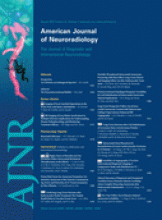Research ArticleNeurointervention
Potent Risk Factor for Aneurysm Formation: Termination Aneurysms of the Anterior Communicating Artery and Detection of A1 Vessel Asymmetry by Flow Dilution
E. Tarulli and A.J. Fox
American Journal of Neuroradiology August 2010, 31 (7) 1186-1191; DOI: https://doi.org/10.3174/ajnr.A2065

References
- 1.↵
- Castro MA,
- Putman CM,
- Sheridan MJ,
- et al
- 2.↵
- 3.↵
- Velthuis BK,
- van Leeuwen MS,
- Witkamp TD,
- et al
- 4.↵
- De Rooij NK,
- Velthuis BK,
- Algra A,
- et al
- 5.↵
- Gonzalez N,
- Sedrak M,
- Martin N,
- et al
- 6.↵
- Bor AS,
- Velthuis BK,
- Majoie CB,
- et al
- 7.↵
- Fox AJ,
- Millar J,
- Raymond J,
- et al
- 8.↵
- Alnaes MS,
- Isaksen J,
- Mardal KA,
- et al
- 9.↵
- Wiebers DO,
- Whisnant JP,
- Huston J 3rd.,
- et al
- 10.↵
- van der Schaaf I,
- Algra A,
- Wermer M,
- et al
- 11.↵
Cerecyte Coil Trial: ISRCTN82461286 Protocol. http://www.cerecytecoiltrial.com/tp.asp?Section=Protocol. Accessed August 2009
- 12.↵
- Charbel FT,
- Seyfried D,
- Mehta B,
- et al
- 13.↵
- Kasuya H,
- Shimizu T,
- Nakaya K,
- et al
- 14.↵
- 15.↵
- Papke K,
- Brassel F
- 16.↵
- Siebert E,
- Bohner G,
- Dewey M,
- et al
In this issue
Advertisement
E. Tarulli, A.J. Fox
Potent Risk Factor for Aneurysm Formation: Termination Aneurysms of the Anterior Communicating Artery and Detection of A1 Vessel Asymmetry by Flow Dilution
American Journal of Neuroradiology Aug 2010, 31 (7) 1186-1191; DOI: 10.3174/ajnr.A2065
0 Responses
Jump to section
Related Articles
- No related articles found.
Cited By...
- Impact of A1 hypoplasia on endovascular treatment outcomes for anterior communicating artery aneurysms: implications for follow-up strategies
- Safety and Efficacy of Flow Diverters for Treatment of Unruptured Anterior Communicating Artery Aneurysms: Retrospective Multicenter Study
- Impact of A1 Asymmetry on the Woven EndoBridge Device in Anterior Communicating Artery Aneurysms
- Flow diversion treatment of aneurysms of the complex region of the anterior communicating artery: which stent placement strategy should 'I use? A single center experience
- Low prevalence of fetal-type posterior cerebral artery in patients with basilar tip aneurysms
- Larger size ratio associated with the rupture of very small (<=3 mm) anterior communicating artery aneurysms
- Treatment of complex anterior cerebral artery aneurysms with Pipeline flow diversion: mid-term results
- Effects of Circle of Willis Anatomic Variations on Angiographic and Clinical Outcomes of Coiled Anterior Communicating Artery Aneurysms
This article has not yet been cited by articles in journals that are participating in Crossref Cited-by Linking.
More in this TOC Section
Similar Articles
Advertisement











